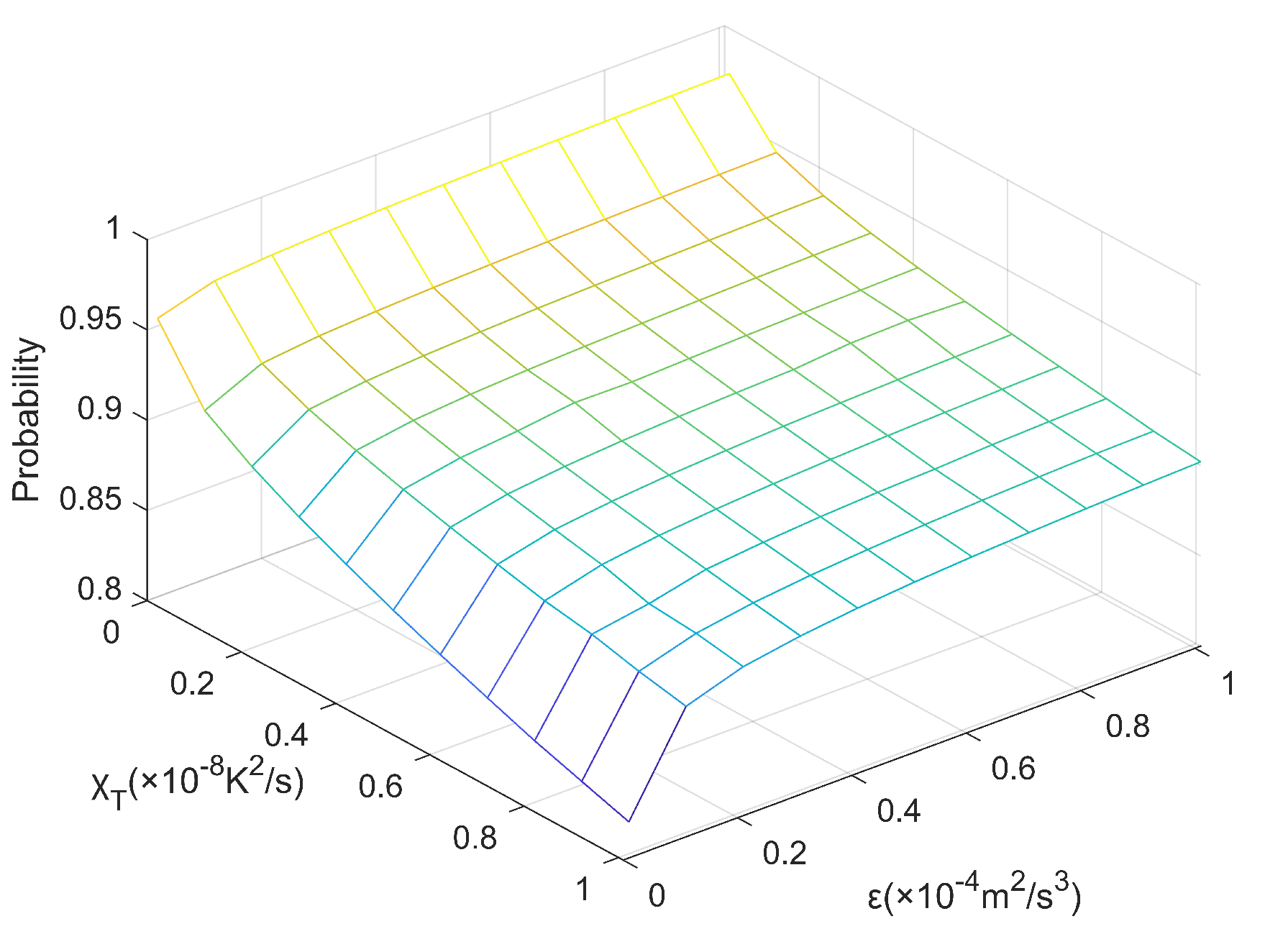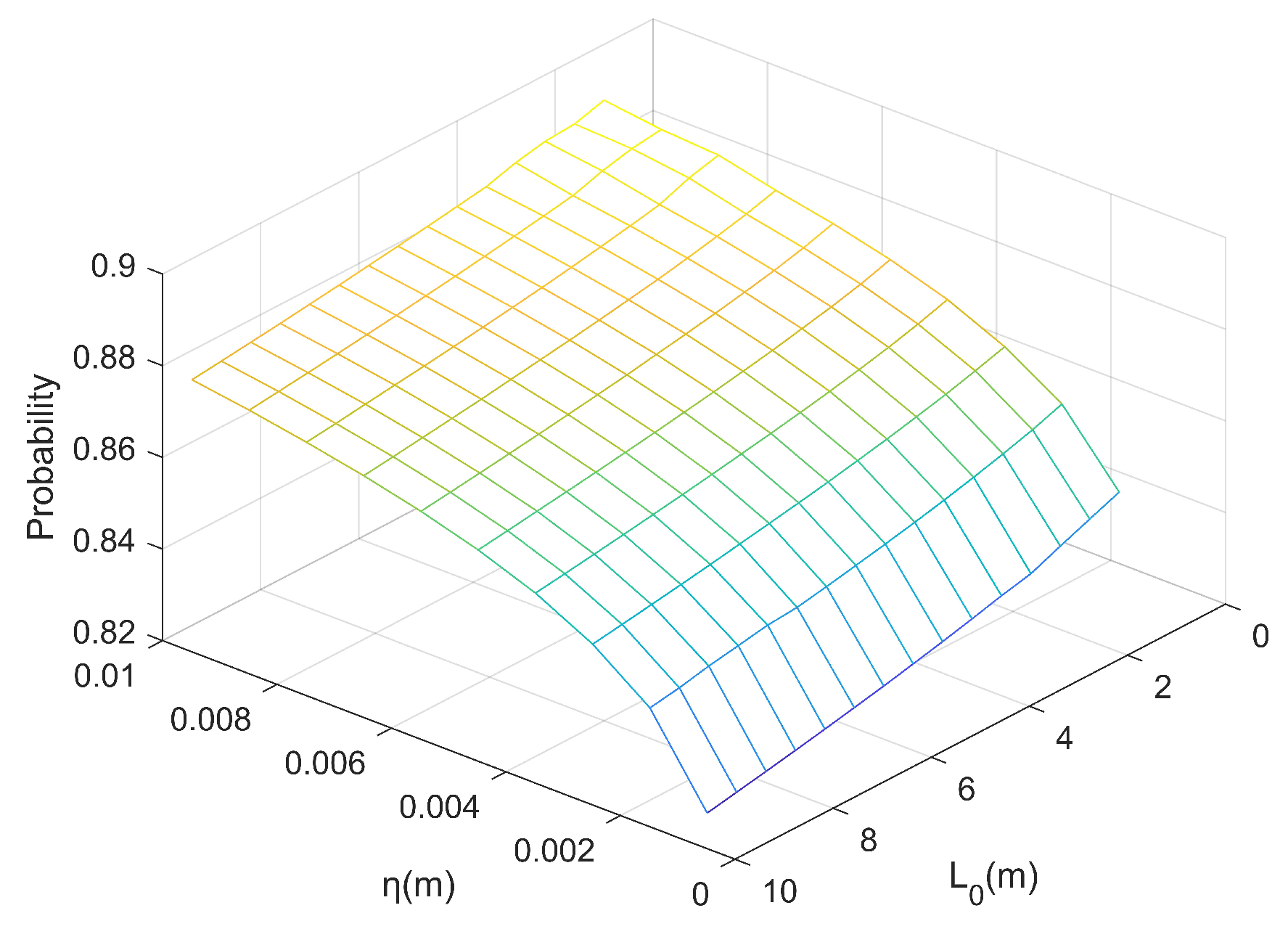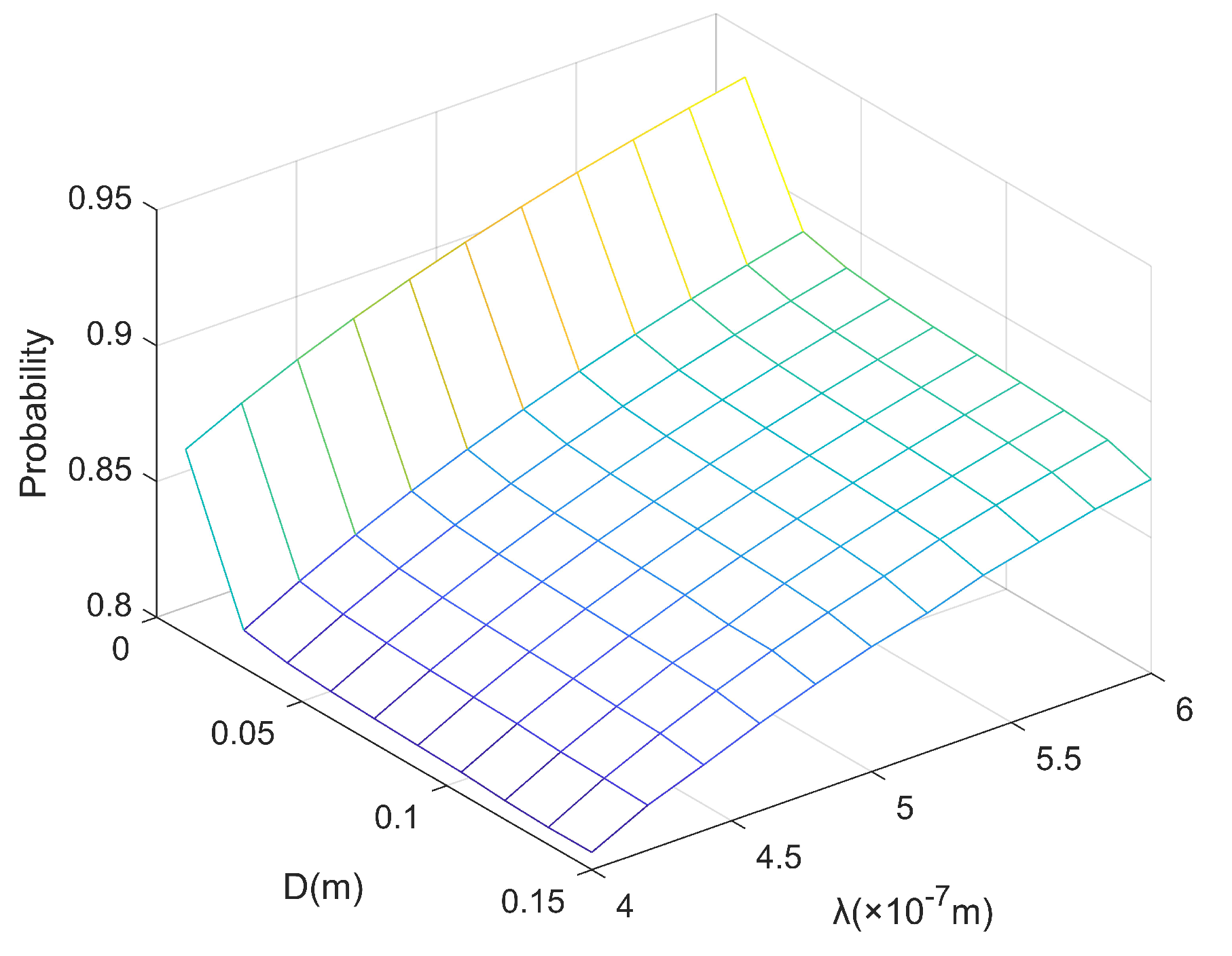Received Probability of Orbital-Angular-Momentum Modes Carried by Diffraction- and Attenuation- Resistant Beams in Weak Turbulent Oceans
Abstract
1. Introduction
2. Statistical Description of the Frozen Wave
3. Received Probability of Orbital-Angular-Momentum Modes
4. Numerical Results and Analysis
5. Conclusions
Author Contributions
Funding
Acknowledgments
Conflicts of Interest
References
- Zeng, Z.; Fu, S.; Zhang, H.; Dong, Y.; Cheng, J. A survey of underwater optical wireless communications. IEEE Commun. Surv. Tutor. 2017, 19, 204–238. [Google Scholar] [CrossRef]
- Zhang, W.; Wang, L.; Wang, W.; Zhao, S. Propagation property of Laguerre-Gaussian beams carrying fractional orbital angular momentum in an underwater channel. OSA Continuum. 2019, 2, 3281–3297. [Google Scholar] [CrossRef]
- Xia, T.; Liu, D.; Dong, A.; Wang, G.; Zhong, H.; Wang, Y. Properties of partially coherent elegant Laguerre-Gaussian beam in free space and oceanic turbulence. Optik 2020, 201, 163514. [Google Scholar] [CrossRef]
- Cheng, M.; Guo, L.; Li, J.; Huang, Q.; Cheng, Q.; Zhang, D. Propagation of an optical vortex carried by a partially coherent Laguerre–Gaussian beam in turbulent ocean. Appl. Opt. 2016, 55, 4642–4648. [Google Scholar] [CrossRef] [PubMed]
- Li, Y.; Zhang, Y.; Zhu, Y. Probability distribution of the orbital angular momentum mode of the ultrashort Laguerre-Gaussian pulsed beam propagation in oceanic turbulence. Results Phys. 2018, 11, 698–705. [Google Scholar] [CrossRef]
- Pan, S.; Wang, L.; Wang, W.; Zhao, S. An effective way for simulating oceanic turbulence channel on the beam carrying orbital angular momentum. Sci. Rep. 2019, 9, 14009. [Google Scholar] [CrossRef]
- Cheng, S.M.; Guo, L.; Li, J.; Zhang, Y. Channel capacity of the OAM-based free-space optical communication Links with Bessel-Gauss beams in turbulent ocean. IEEE Photon. J. 2016, 8, 7901411. [Google Scholar] [CrossRef]
- Zhao, S.; Zhang, W.; Wang, L.; Li, W.; Gong, L.; Cheng, W.; Chen, H.; Gruska, J. Propagation and self-healing properties of Bessel-Gaussian beam carrying orbital angular momentum in an underwater environment. Sci. Rep. 2019, 9, 2025. [Google Scholar] [CrossRef]
- Wang, X.; Yang, Z.; Zhao, S. Influence of oceanic turbulence on propagation of Airy vortex beam carrying orbital angular momentum. Optik 2019, 176, 49–55. [Google Scholar] [CrossRef]
- Yu, L.; Zhang, Y. Analysis of modal crosstalk for communication in turbulent ocean using Lommel-Gaussian beam. Opt. Express 2017, 25, 22565–22574. [Google Scholar] [CrossRef]
- Liang, Q.; Zhu, Y.; Zhang, Y. Approximations wander model for the Lommel Gaussian-Schell beam through unstable stratification and weak ocean-turbulence. Results Phys. 2019, 14, 102511. [Google Scholar] [CrossRef]
- Li, Y.; Yu, L.; Zhang, Y. Influence of anisotropic turbulence on the orbital angular momentum modes of Hermite-Gaussian vortex beam in the ocean. Opt. Express 2017, 25, 12203–12215. [Google Scholar] [CrossRef] [PubMed]
- Xu, Y.; Shi, H.; Zhang, Y. Effects of anisotropic oceanic turbulence on the power of the bandwidth-limited OAM mode of partially coherent modified Bessel correlated vortex beams. J. Opt. Soc. Am. A 2018, 35, 1839–1845. [Google Scholar] [CrossRef] [PubMed]
- Li, Y.; Zhang, Y.; Zhu, Y. Influence of oceanic turbulence on propagation of the Gaussian pulsed X wave carrying orbital angular momentum. Opt. Commun. 2018, 428, 57–62. [Google Scholar] [CrossRef]
- Yang, D.; Zhang, Y.; Shi, H. Capacity of turbulent ocean links with carrier Bessel–Gaussian localized vortex waves. Appl. Opt. 2019, 58, 9484–9490. [Google Scholar] [CrossRef]
- Deng, S.; Zhu, Y.; Zhang, Y. Received probability of vortex modes carried by localized wave of Bessel-Gaussian amplitude envelope in turbulent seawater. J. Mar. Sci. Eng. 2019, 7, 203. [Google Scholar] [CrossRef]
- Deng, S.; Yang, D.; Zheng, Y.; Hu, L.; Zhang, Y. Transmittance of finite-energy frozen beams in oceanic turbulence. Results Phys. 2019, 15, 102802. [Google Scholar] [CrossRef]
- Yin, X.; Chang, H.; Cui, X.; Ma, J.; Wang, Y.; Wu, G.; Zhang, L.; Xin, X. Adaptive turbulence compensation with a hybrid input–output algorithm in orbital angular momentum-based free-space optical communication. Appl. Opt. 2018, 57, 7644–7650. [Google Scholar] [CrossRef]
- Cui, X.; Yin, X.; Chang, H.; Liao, H.; Chen, X.; Xin, X.; Wang, Y. Experimental study of machine-learning-based orbital angular momentum shift keying decoders in optical underwater channels. Opt. Commun. 2019, 452, 116–123. [Google Scholar] [CrossRef]
- Cui, X.; Yin, X.; Chang, H.; Guo, Y.; Zheng, Z.; Sun, Z.; Liu, G.; Wang, Y. Analysis of an adaptive orbital angular momentum shift keying decoder based on machine learning under oceanic turbulence channels. Opt. Commun. 2018, 429, 138–143. [Google Scholar] [CrossRef]
- Wang, W.; Wang, P.; Cao, T.; Tian, H.; Zhang, Y.; Guo, L. Performance investigation of underwater wireless optical communication system using M-ary OAMSK modulation over oceanic turbulence. IEEE Photon. J. 2017, 9, 7905315. [Google Scholar] [CrossRef]
- Allen, L.; Beijersbergen, M.W.; Spreeuw, R.J.C.; Woerdman, J.P. Orbital angular momentum of light and the transformation of Laguerre-Gaussian laser modes. Phys. Rev. A 1992, 45, 8185. [Google Scholar] [CrossRef] [PubMed]
- Mair, A.; Vaziri, A.; Weihs, G.; Zeilinger, A. Entanglement of the orbital angular momentum states of photons. Nature 2001, 412, 313–316. [Google Scholar] [CrossRef] [PubMed]
- Dorrah, A.H.; Zamboni-Rached, M.; Mojahedi, M. Controlling the topological charge of twisted light beams with propagation. Phys. Rev. A 2016, 93, 063864. [Google Scholar] [CrossRef]
- Tian, Q.; Zhu, L.; Wang, Y.; Zhang, Q.; Liu, B.; Xin, X. The Propagation Properties of a Longitudinal Orbital Angular Momentum Multiplexing System in Atmospheric Turbulence. IEEE Photonics J. 2018, 10, 1–16. [Google Scholar] [CrossRef]
- Zamboni-Rached, M.; Ambrósio, L.A.; Hernández-Figueroa, H.E. Diffraction-attenuation resistant beams: Their higher-order versions and finite-aperture generations. Appl. Opt. 2010, 49, 5861–5869. [Google Scholar] [CrossRef]
- Davis, C. DLaser and Electro-Optics; McGraw-Hill: Cambridge, UK; New York, NY, USA, 1996; Volume 49. [Google Scholar]
- Zamboni-Rached, M.; Mojahedi, M. Shaping finite-energy diffraction- and attenuation-resistant beams through Bessel-Gauss–beam superposition. Phys. Rev. A 2005, 92, 043839. [Google Scholar] [CrossRef]
- Andrews, L.C.; Philips, R.L. Laser Beam Propagation through Random Media; SPIE: Washington, DC, USA, 2005. [Google Scholar]
- Nikishov, V.V.; Nikishov, V.I. Spectrum of turbulent fluctuations of the sea-water refraction index. Int. J. Fluid Mech. Res. 2000, 27, 82–98. [Google Scholar] [CrossRef]
- Gradshteyn, I.S.; Ryzhik, I.M. Table of Integrals, Series, and Products; Elsevier: Amsterdam, The Netherlands, 2007. [Google Scholar]
- Fewell, M.P.; Von, A. Trojan Absorption of light by water in the region of high transparency: Recommended values for photon-transport calculations. Appl. Opt. 2019, 58, 2408–2421. [Google Scholar] [CrossRef]
- Tyler, A.G.; Boyd, R.W. Influence of atmospheric turbulence on the propagation of quantum states of light carrying orbital angular momentum. Opt. Lett. 2009, 34, 142–144. [Google Scholar] [CrossRef]





© 2020 by the authors. Licensee MDPI, Basel, Switzerland. This article is an open access article distributed under the terms and conditions of the Creative Commons Attribution (CC BY) license (http://creativecommons.org/licenses/by/4.0/).
Share and Cite
Zheng, Y.; Yang, D.; Qin, S.; Zhang, Y. Received Probability of Orbital-Angular-Momentum Modes Carried by Diffraction- and Attenuation- Resistant Beams in Weak Turbulent Oceans. J. Mar. Sci. Eng. 2020, 8, 701. https://doi.org/10.3390/jmse8090701
Zheng Y, Yang D, Qin S, Zhang Y. Received Probability of Orbital-Angular-Momentum Modes Carried by Diffraction- and Attenuation- Resistant Beams in Weak Turbulent Oceans. Journal of Marine Science and Engineering. 2020; 8(9):701. https://doi.org/10.3390/jmse8090701
Chicago/Turabian StyleZheng, Yuan, Dongyu Yang, Shiqing Qin, and Yixin Zhang. 2020. "Received Probability of Orbital-Angular-Momentum Modes Carried by Diffraction- and Attenuation- Resistant Beams in Weak Turbulent Oceans" Journal of Marine Science and Engineering 8, no. 9: 701. https://doi.org/10.3390/jmse8090701
APA StyleZheng, Y., Yang, D., Qin, S., & Zhang, Y. (2020). Received Probability of Orbital-Angular-Momentum Modes Carried by Diffraction- and Attenuation- Resistant Beams in Weak Turbulent Oceans. Journal of Marine Science and Engineering, 8(9), 701. https://doi.org/10.3390/jmse8090701



